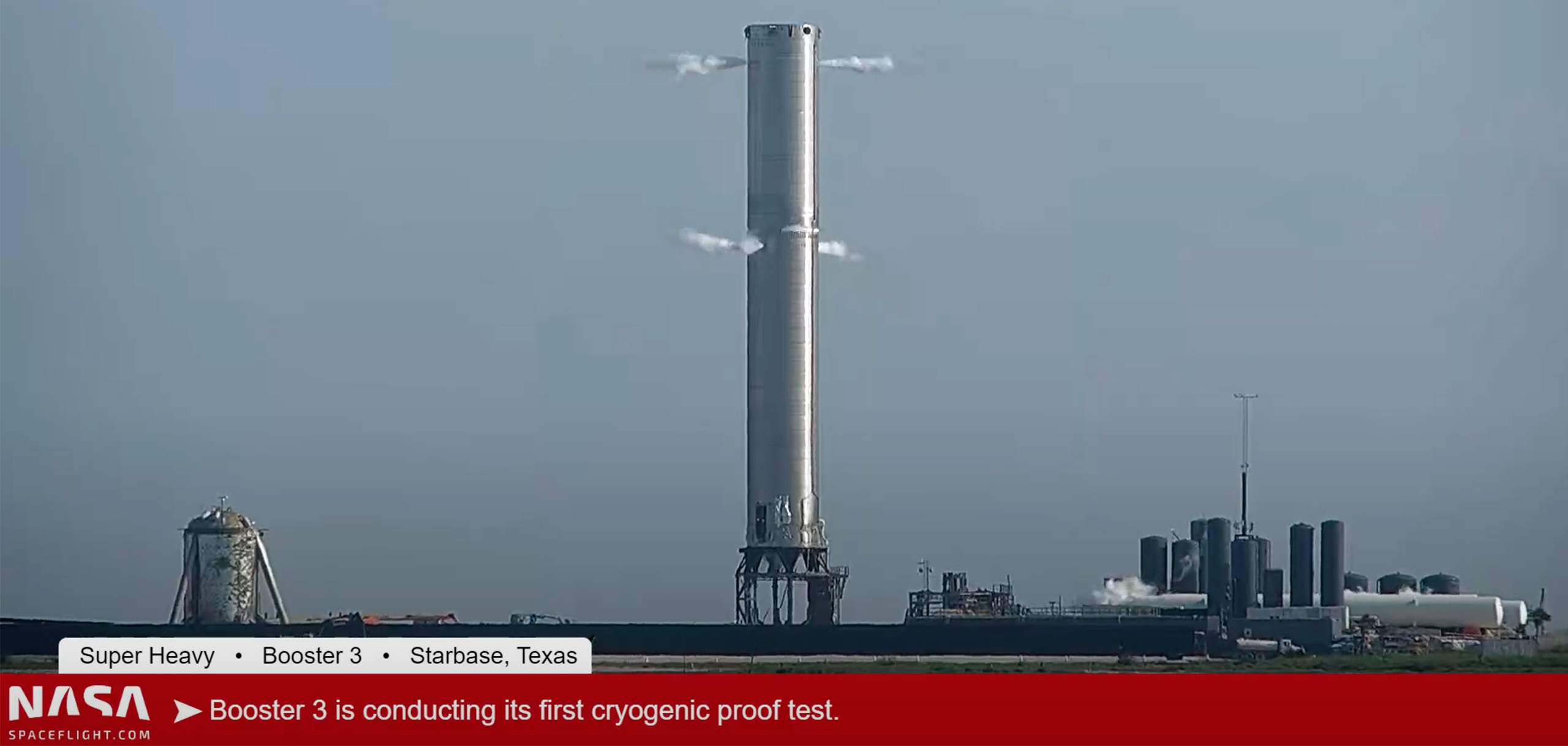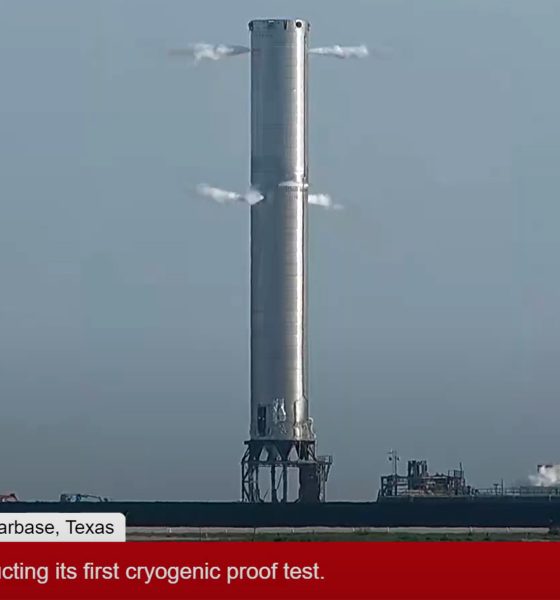

News
SpaceX Super Heavy booster survives first major test
A SpaceX Super Heavy booster prototype has survived its first major test seemingly without issue, potentially opening the door for a static fire test with several Raptor engines as early as this week.
Not long after the latest line of propellant storage implements was transported from SpaceX’s Boca Chica, Texas factory to Starship’s first orbital launch pad, the company officially closed the one highway to the pad and nearby beach. By ~4:30pm CDT (UTC-5), the first major test of an integrated Starship booster was under way and clouds of cryogenic vapors were pouring off of Super Heavy B3’s thrust (aft) dome as the humid air came in contact with steel cooled to around –330°F (–200°C).
While technically known as a cryogenic proof test, Booster 3’s first major challenge looked more like a basic pressure test. Curiously, only small amount of frost – the telltale sign of a ‘cryo proof’ – formed on the outside of Super Heavy’s ~65m (~215 ft) tall propellant tanks in two hours of activity, indicating that SpaceX likely chose a more cautious approach to Booster 3’s first cryo proof.
In short, Booster 3 was likely filled with a few hundred tons of liquid nitrogen relative to the more than 3000 tons its tanks could easily hold and the fraction of that total capacity SpaceX’s suborbital launch site can actually supply. Teams have been working around the clock for months to outfit Starship’s first orbital launch site with enough propellant storage for at least one or two back to back orbital launches – on the order of 10,000 tons (~22M lb) – but the nascent tank farm is far from even partially operational. That’s left SpaceX with its ground testing and suborbital Starship launch facilities, which appear to be able to store around 1200 tons of propellant.
Assuming the suborbital pad’s main liquid oxygen and methane tanks can also both store and distribute liquid nitrogen, which isn’t guaranteed, SpaceX thus has the ability to fill approximately 30-40% of Super Heavy B3’s usable volume. Frost lines aren’t always a guaranteed sign of fill level but if they’re close, SpaceX likely filled Booster 3’s tanks just 5-10% of the way during the rocket’s first cryoproof.
Based on loud, visible venting that occurred throughout the process, it’s likely that Super Heavy’s first cryo proof was more focused on pressure testing with just a small taste of the true thermal shock, loads, and general mechanical stress Starship boosters will have to withstand when loaded with thousands of tons of propellant and generating thousands of tons of thrust with dozens of Raptor engines.
Following July 12th’s test, Super Heavy B3’s next steps could either be one or several additional cryo proofs or a static fire test with an unknown number of Raptor engines installed. The booster completed Monday’s testing with one Raptor installed, while the most engines ever tested simultaneously is three. SpaceX has yet to update backup test windows scheduled from noon to 10pm CDT on July 13th, 14th, and 15th, any of which could be used for additional cryo proof or static fire testing.

News
Tesla starts showing how FSD will change lives in Europe
Local officials tested the system on narrow country roads and were impressed by FSD’s smooth, human-like driving, with some calling the service a game-changer for everyday life in areas that are far from urban centers.

Tesla has launched Europe’s first public shuttle service using Full Self-Driving (Supervised) in the rural Eifelkreis Bitburg-Prüm region of Germany, demonstrating how the technology can restore independence and mobility for people who struggle with limited transport options.
Local officials tested the system on narrow country roads and were impressed by FSD’s smooth, human-like driving, with some calling the service a game-changer for everyday life in areas that are far from urban centers.
Officials see real impact on rural residents
Arzfeld Mayor Johannes Kuhl and District Administrator Andreas Kruppert personally tested the Tesla shuttle service. This allowed them to see just how well FSD navigated winding lanes and rural roads confidently. Kruppert said, “Autonomous driving sounds like science fiction to many, but we simply see here that it works totally well in rural regions too.” Kuhl, for his part, also noted that FSD “feels like a very experienced driver.”
The pilot complements the area’s “Citizen Bus” program, which provides on-demand rides for elderly residents who can no longer drive themselves. Tesla Europe shared a video of a demonstration of the service, highlighting how FSD gives people their freedom back, even in places where public transport is not as prevalent.
What the Ministry for Economic Affairs and Transport says
Rhineland-Palatinate’s Minister Daniela Schmitt supported the project, praising the collaboration that made this “first of its kind in Europe” possible. As per the ministry, the rural rollout for the service shows FSD’s potential beyond major cities, and it delivers tangible benefits like grocery runs, doctor visits, and social connections for isolated residents.
“Reliable and flexible mobility is especially vital in rural areas. With the launch of a shuttle service using self-driving vehicles (FSD supervised) by Tesla in the Eifelkreis Bitburg-Prüm, an innovative pilot project is now getting underway that complements local community bus services. It is the first project of its kind in Europe.
“The result is a real gain for rural mobility: greater accessibility, more flexibility and tangible benefits for everyday life. A strong signal for innovation, cooperation and future-oriented mobility beyond urban centers,” the ministry wrote in a LinkedIn post.
News
Tesla China quietly posts Robotaxi-related job listing
Tesla China is currently seeking a Low Voltage Electrical Engineer to work on circuit board design for the company’s autonomous vehicles.

Tesla has posted a new job listing in Shanghai explicitly tied to its Robotaxi program, fueling speculation that the company is preparing to launch its dedicated autonomous ride-hailing service in China.
As noted in the listing, Tesla China is currently seeking a Low Voltage Electrical Engineer to work on circuit board design for the company’s autonomous vehicles.
Robotaxi-specific role
The listing, which was shared on social media platform X by industry watcher @tslaming, suggested that Tesla China is looking to fill the role urgently. The job listing itself specifically mentions that the person hired for the role will be working on the Low Voltage Hardware team, which would design the circuit boards that would serve as the nervous system of the Robotaxi.
Key tasks for the role, as indicated in the job listing, include collaboration with PCB layout, firmware, mechanical, program management, and validation teams, among other responsibilities. The role is based in Shanghai.
China Robotaxi launch
China represents a massive potential market for robotaxis, with its dense urban centers and supportive policies in select cities. Tesla has limited permission to roll out FSD in the country, though despite this, its vehicles have been hailed as among the best in the market when it comes to autonomous features. So far, at least, it appears that China supports Tesla’s FSD and Robotaxi rollout.
This was hinted at in November, when Tesla brought the Cybercab to the 8th China International Import Expo (CIIE) in Shanghai, marking the first time that the autonomous two-seater was brought to the Asia-Pacific region. The vehicle, despite not having a release date in China, received a significant amount of interest among the event’s attendees.
Elon Musk
Elon Musk and Tesla AI Director share insights after empty driver seat Robotaxi rides
The executives’ unoccupied tests hint at the rapid progress of Tesla’s unsupervised Robotaxi efforts.

Tesla CEO Elon Musk and AI Director Ashok Elluswamy celebrated Christmas Eve by sharing personal experiences with Robotaxi vehicles that had no safety monitor or occupant in the driver’s seat. Musk described the system’s “perfect driving” around Austin, while Elluswamy posted video from the back seat, calling it “an amazing experience.”
The executives’ unoccupied tests hint at the rapid progress of Tesla’s unsupervised Robotaxi efforts.
Elon and Ashok’s firsthand Robotaxi insights
Prior to Musk and the Tesla AI Director’s posts, sightings of unmanned Teslas navigating public roads were widely shared on social media. One such vehicle was spotted in Austin, Texas, which Elon Musk acknowleged by stating that “Testing is underway with no occupants in the car.”
Based on his Christmas Eve post, Musk seemed to have tested an unmanned Tesla himself. “A Tesla with no safety monitor in the car and me sitting in the passenger seat took me all around Austin on Sunday with perfect driving,” Musk wrote in his post.
Elluswamy responded with a 2-minute video showing himself in the rear of an unmanned Tesla. The video featured the vehicle’s empty front seats, as well as its smooth handling through real-world traffic. He captioned his video with the words, “It’s an amazing experience!”
Towards Unsupervised operations
During an xAI Hackathon earlier this month, Elon Musk mentioned that Tesla owed be removing Safety Monitors from its Robotaxis in Austin in just three weeks. “Unsupervised is pretty much solved at this point. So there will be Tesla Robotaxis operating in Austin with no one in them. Not even anyone in the passenger seat in about three weeks,” he said. Musk echoed similar estimates at the 2025 Annual Shareholder Meeting and the Q3 2025 earnings call.
Considering the insights that were posted Musk and Elluswamy, it does appear that Tesla is working hard towards operating its Robotaxis with no safety monitors. This is quite impressive considering that the service was launched just earlier this year.








